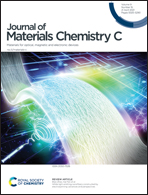Anthracene-based bipolar deep-blue emitters for efficient white OLEDs with ultra-high stabilities of emission color and efficiency†
Abstract
Blue organic luminescent materials are important because of their applications in illumination and full-color displays, but those with high efficiency and stable emission are insufficient. Herein, two new luminescent compounds, 10-(4-(10-(4-(carbazol-9-yl)phenyl)-2,6-di-tert-butylanthracen-9-yl)phenyl)-9,9-dimethyl-9,10-dihydroacridine (Cz-TAn-DMAC) and 4-(2,6-di-tert-butyl-10-(4-(9,9-dimethylacridin-10-yl)phenyl)anthracen-9-yl)-N,N-diphenylaniline (TPA-TAn-DMAC), comprising tert-butyl-modified anthracene, dimethyl acridine and carbazole or triphenylamine groups are successfully synthesized, and their thermal stability, optical property, electronic structure, and electrochemical behavior are measured and analyzed. They exhibit efficient deep-blue emissions in neat films and bipolar carrier transport ability. The non-doped OLED based on TPA-TAn-DMAC provides bright deep-blue light (CIEx,y = 0.14, 0.18) with a high external quantum efficiency (ηext) of 4.9%, and the doped OLED of Cz-TAn-DMAC radiates blue light (CIEx,y = 0.15, 0.08) with a ηext of 4.8%. In addition, two-color hybrid warm white OLEDs with high-performance are fabricated by using TPA-TAn-DMAC as the blue emission layer, thus achieving ultra-high stability, efficiency and color at high luminance over 10 000 cd m−2, indicative of a very promising OLED application prospect.



 Please wait while we load your content...
Please wait while we load your content...